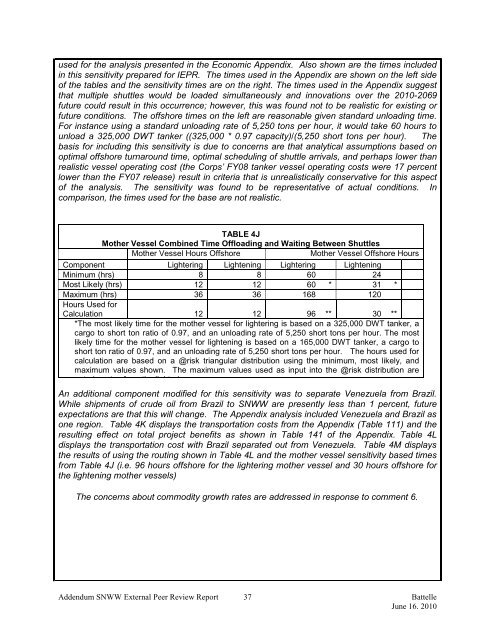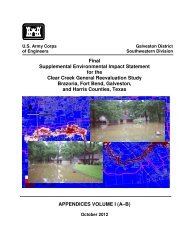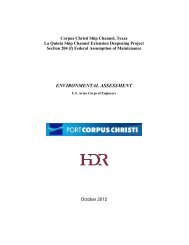SABINE-NECHES WATERWAY (SNWW) CHANNEL IMPROVEMENT PROJECT FEASIBILITY STUDY
Sabine-Neches Waterway IEPR report ... - Galveston District
Sabine-Neches Waterway IEPR report ... - Galveston District
- No tags were found...
Create successful ePaper yourself
Turn your PDF publications into a flip-book with our unique Google optimized e-Paper software.
used for the analysis presented in the Economic Appendix. Also shown are the times included<br />
in this sensitivity prepared for IEPR. The times used in the Appendix are shown on the left side<br />
of the tables and the sensitivity times are on the right. The times used in the Appendix suggest<br />
that multiple shuttles would be loaded simultaneously and innovations over the 2010-2069<br />
future could result in this occurrence; however, this was found not to be realistic for existing or<br />
future conditions. The offshore times on the left are reasonable given standard unloading time.<br />
For instance using a standard unloading rate of 5,250 tons per hour, it would take 60 hours to<br />
unload a 325,000 DWT tanker ((325,000 * 0.97 capacity)/(5,250 short tons per hour). The<br />
basis for including this sensitivity is due to concerns are that analytical assumptions based on<br />
optimal offshore turnaround time, optimal scheduling of shuttle arrivals, and perhaps lower than<br />
realistic vessel operating cost (the Corps’ FY08 tanker vessel operating costs were 17 percent<br />
lower than the FY07 release) result in criteria that is unrealistically conservative for this aspect<br />
of the analysis. The sensitivity was found to be representative of actual conditions. In<br />
comparison, the times used for the base are not realistic.<br />
TABLE 4J<br />
Mother Vessel Combined Time Offloading and Waiting Between Shuttles<br />
Mother Vessel Hours Offshore<br />
Mother Vessel Offshore Hours<br />
Component ( Lightering )<br />
Lightening Lightering Lightening (S )<br />
Minimum (hrs) 8 8 60 24<br />
Most Likely (hrs) 12 12 60 * 31 *<br />
Maximum (hrs) 36 36 168 120<br />
Hours Used for<br />
Calculation 12 12 96 ** 30 **<br />
*The most likely time for the mother vessel for lightering is based on a 325,000 DWT tanker, a<br />
cargo to short ton ratio of 0.97, and an unloading rate of 5,250 short tons per hour. The most<br />
likely time for the mother vessel for lightening is based on a 165,000 DWT tanker, a cargo to<br />
short ton ratio of 0.97, and an unloading rate of 5,250 short tons per hour. The hours used for<br />
calculation are based on a @risk triangular distribution using the minimum, most likely, and<br />
maximum values shown. The maximum values used as input into the @risk distribution are<br />
t d t f th li ht i<br />
An additional component modified for this sensitivity was to separate Venezuela from Brazil.<br />
While shipments of crude oil from Brazil to <strong>SNWW</strong> are presently less than 1 percent, future<br />
expectations are that this will change. The Appendix analysis included Venezuela and Brazil as<br />
one region. Table 4K displays the transportation costs from the Appendix (Table 111) and the<br />
resulting effect on total project benefits as shown in Table 141 of the Appendix. Table 4L<br />
displays the transportation cost with Brazil separated out from Venezuela. Table 4M displays<br />
the results of using the routing shown in Table 4L and the mother vessel sensitivity based times<br />
from Table 4J (i.e. 96 hours offshore for the lightering mother vessel and 30 hours offshore for<br />
the lightening mother vessels)<br />
The concerns about commodity growth rates are addressed in response to comment 6.<br />
Addendum <strong>SNWW</strong> External Peer Review Report 37 Battelle<br />
June 16. 2010






